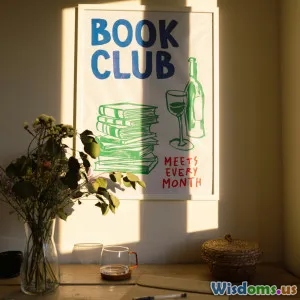
The Rise of Indie Authors How Self Publishing Fuels New Voices
8 min read Explore how indie authors rise through self-publishing, amplifying diverse voices in the literary world. (0 Reviews)
The Rise of Indie Authors: How Self-Publishing Fuels New Voices
Introduction
Over the last decade, the literary world has witnessed a monumental shift that is transforming how stories are told, shared, and celebrated. The rise of indie authors—those who publish their works independently without traditional publishing houses—has rewritten the rules. Thanks to the democratizing power of self-publishing, countless fresh voices that might have otherwise remained unheard are enriching global literature with diverse perspectives and innovative ideas.
This article delves into this indie author revolution, exploring how self-publishing fuels new voices, the challenges and triumphs of indie authors, and why this movement is vital for the future of storytelling.
Breaking the Chains of Traditional Publishing
Traditional publishing has long been gatekept by a handful of major companies that control what reaches bookshelves and digital storefronts. Manuscripts had to pass through rigorous submission processes, sometimes involving agents, editors, and lengthy review cycles. This conservatism often meant that only market-certain stories were published—leading to underrepresentation of marginalized voices or unconventional ideas.
The Accessibility of Self-Publishing
Self-publishing platforms such as Amazon’s Kindle Direct Publishing (KDP), Smashwords, and Draft2Digital have lowered barriers to entry. Now, an author with a finished manuscript can upload it instantly and make it available worldwide. According to the Alliance of Independent Authors, over 1.68 million indie books were self-published globally in 2020 alone, signaling a surge in this trend.
Example: Amanda Hocking
Amanda Hocking is often cited as a poster child for self-publishing success. In 2010, she self-published her paranormal fiction e-books and sold over a million copies before securing a traditional deal. Her success story inspired countless others to bypass conventional routes and maintain full creative control.
Amplifying Diverse Voices and Niche Stories
One of the most enriching aspects of self-publishing is its ability to diversify the literary voice.
Empowering Marginalized Communities
Historically, racial minorities, LGBTQ+ authors, and writers from non-Western cultures faced significant obstacles to traditional publication. Self-publishing has empowered many to tell their authentic stories on their own terms. For instance, self-published works like „Freshwater“ by Nigerian-American writer Akwaeke Emezi initially gained traction online before widespread acclaim.
Catering to Niche Audiences
Traditional publishers often shy away from niche genres or experimental writing due to perceived limited marketability. Indie authors can cater directly to specialized readerships—such as cozy mysteries, LGBTQ+ speculative fiction, or historical erotica—through the power of targeted marketing on social media and book communities.
The Role of Social Media
Platforms like TikTok (#BookTok), Instagram, and Goodreads have become powerful tools for indie authors to build communities and gain viral exposure without hefty marketing budgets. For example, R.F. Kuang, known for her fantasy novels, initially built a strong follower base online, supporting her indie endeavors.
Economic and Creative Freedom
Financial Incentives
While self-publishing involves risks and personal investment, it offers better royalty rates compared to traditional publishing (often 70% versus 10-15%). This means indie authors can earn substantially more per book sold.
According to a 2023 Author Earnings report, many self-published authors consistently earn four- and five-figure incomes yearly, with top performers generating six or seven figures.
Control Over Creative Process
Indie authors exercise complete creative freedom—from cover design and pricing to content and release timelines. This autonomy allows experimentation and bold storytelling without pressure from market-driven editors.
Example: Hugh Howey
Hugh Howey initially self-published his sci-fi novella "Wool" as short e-books. The series became a massive hit, eventually attracting Hollywood interest. Yet he maintained control over his work, illustrating how self-publishing provides a flexible path to success.
Challenges Faced by Indie Authors
While self-publishing opens doors, it's not without challenges.
Discoverability
With millions of titles available, visibility is a critical hurdle. Indie authors must often master marketing, social media engagement, and networking to attract readers.
Quality Control
Without traditional editorial oversight, poor editing or inconsistent formatting can undermine a book’s success. Many indie authors invest in professional editors and designers to maintain high standards.
Building Credibility
Some readers remain skeptical of self-published works, associating them with lower quality. However, this stigma is rapidly fading as indie authors win awards and bestseller lists.
The Future of Literature: A Democratized Era
The rise of indie authors signals a shift towards a more inclusive literary ecosystem. With platforms continuously evolving and audiobooks gaining popularity, self-published voices are poised to reach even larger audiences.
Programs such as Kindle Vella for serialized storytelling and subscription services like Scribd create new avenues for indie authors to innovate.
Literary awards like the Selfies (Self-Published Book Awards) acknowledge the quality and creativity flourishing within indie circles, further legitimizing their impact.
Conclusion
The rise of indie authors through self-publishing is an inspiring testament to the democratization of literature. By breaking down barriers and championing diverse, unique voices, self-publishing fuels innovation and inclusivity in storytelling.
For readers, this means richer, more varied narratives. For writers, it offers unprecedented freedom and opportunity.
Whether you’re an aspiring author or an avid reader, understanding this paradigm shift helps appreciate the vibrant literary tapestry that indie authors weave, signaling a bright and open future for stories yet to be told.
References:
- Alliance of Independent Authors Annual Reports
- Author Earnings Report 2023
- "How Amanda Hocking Got Famous," The Guardian
- Case studies on R.F. Kuang and Hugh Howey
- Selfies Book Awards official site
Author’s Note: If you’re inspired by this wave of indie publishing, consider exploring self-publishing platforms or supporting indie authors to keep these new voices thriving.
Rate the Post
User Reviews
Popular Posts





















